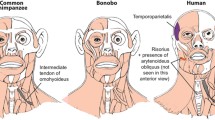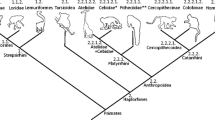Abstract
Biological clock data from protein sequences indicate times for the divergence of humans and African apes that are only 2–3 million years before the present and hence inconsistent with the generally accepted view ofAustralopithecus on the evolutionary line toHomo. This inconsistency has been reconciled for most investigators by postulating a slowing of the biological clock among higher primates. However, there is no independent evidence for such a slowing, and for a number of reasons a specific slowing is unlikely. Therefore, an alternative paradigm is considered here based on the hypothesis that the molecular clock data are correct. The main consequence of this hypothesis is the placement ofA. afarensis in a position ancestral to African apes. An argument in support of this alternative paradigm is formulated concerning the evolution of knuckle-walking in African apes from ancestors whose bipedalism was already well developed. Published data are cited, particularly concerning the structure of the wrist, which accommodate poorly the evolution of African apes from palmigrad-walking or brachiating ancestors resemblingProconsul africanus orPongo. These arguments suggest that an alternative paradigm of hominoid evolution placingA. afarensis ancestral toHomo, Gorilla, andPan warrants further consideration.
Similar content being viewed by others
References
Aiello L. C., 1981.The allometry of primate body proportions. Symposium Zoological Society London, 48: 331–358.
Andrews P. &Cronin J. E., 1982.The relationships of Sivapithecus and Ramapithecus and the evolution of the orang-utan. Nature, 297: 541–546.
Britten R. J., 1986.Rates of DNA sequence evolution differ between taxonomic groups. Science, 231: 1393–1398.
Brown W. M., Prager E. M., Wang A. &Wilson A. C., 1982.Mitochondrial DNA sequences of primates: tempo and mode of evolution. Journal of Molecular Evolution, 18: 225–239.
Conroy G. C. &Fleagle J. G., 1972.Locomotor behavior in living and fossil pongids. Nature, 237: 103–104.
Corruccini R. S., Cronin J. E. &Ciochon R., 1979.Scaling analysis and congruence among anthropoid primate macromolecules. Human Biology, 51: 167–185.
Edelstein S. J., 1986.The Sickled Cell, pp. 34–37, Harvard, Cambridge.
Edelstein S. J., 1981.Molecular topology in crystals and fibers of hemoglobin. Journal of Molecular Biology, 150: 557–575.
Ferris S. D., Wilson A. C. &Brown W. M., 1981.Extensive polymorphism in the mitochondrial DNA of apes. Proceedings of the National Academy of Sciences, U.S.A., 78: 2432–2436.
Goodman M., 1963.Man's place in the phylogeny of the primates as reflected in serum proteins. In (S. L. Washburn, ed.) Classification and Human Evolution, pp., 204–234, Aldine, Chicago.
Goodman M., Baba M. L. &Darga L. L., 1983a.The bearing of molecular data on the cladogenesis and times of divergence of hominoid lineages. In (R. L. Ciochon, & R. S. Corruccini, eds.) New Interpretations of Ape and Human Ancestry, pp. 67–86, Plenum, New York.
Goodman M., Braunitzer G., Stangl A. &Schrank, 1983.Evidence on human origins from hemogrobins of African apes. Nature, 303: 546–548.
Gould S. J., 1982.The meaning of punctuated equilibrium and its role in validating a hierarchical approach to macroevolution. In (R. Milkman, ed.) Perspectives on Evolution, pp. 83–104, Sinauer, Sunderland.
Johanson D. C., Taieb M. &Coppens Y., 1982.Stratigraphic, chronologic, and paleoenvironmental contexts, with notes on hominoid morphology and systematics. American Journal of Physical Anthropology, 57: 373–402.
Johanson D. C. &White T. D., 1979.A systematic assessment of early African Hominids. Science, 203: 321–330.
Koop B. F., Goodman M., Xu P., Chan K. &Slightom J. L., 1986.Primate beta-globin DNA sequences and man's place among the great apes. Nature, 319: 234–238.
Lessertisseur J. &Jouffroy F. K., 1975.Comparative osteometry of the foot of man and facultatively bipedal primates. In (R. H. Tuttle, ed.) Primate functional Morphology and Evolution, pp. 203–212, Mouton, The Hague.
Lewis O. J., 1971.Brachiation and the early evolution of the Hominoidea. Nature, 230: 577–578.
McHenry H. M. &Corruccini R. S., 1983.The wrist of Proconsul africanus. In (R. L. Ciochon & R. S. Corruccini, eds) New Interpretations of Ape and Human Ancestry, pp. 353–367, Plenum, New York.
Sarich V. M. &Cronin J. E., 1976.Molecular systematics of the primates. In (M. Goodman & R. E. Tashian, eds.) Molecular Anthropology, pp. 141–160, Plenum, New York.
Sarich V. M. &Wilson A. C., 1967.Immunulogical time scale for hominid evolution. Science, 158: 1200–1203.
Savatier P., Trabuchet G., Faure C., Chebloune Y., Gouy M., Verdier G. &Nigon V. M., 1985.Evolution of the primate beta-globin gene region. High rate of variation in CpG dinucleotides and in short repeated sequences between man and chimpanzee. Journal of Molecular Biology, 182: 21–29.
Sibley C. G. &Ahlquist J. E., 1984.The phylogeny of the hominoid primates as indicated by DNA-DNA hybridization. Journal of Molecular Evolution, 20: 2–15.
Stern J. T. &Susman R. L., 1981.Electromyography of the gluteal muscles in Hylobates, Pongo, and Pan: implication for the evolution of hominid bipedality. American Journal of Physical Anthropology 55: 153–166.
Templeton A. R., 1983.Phylogenetic inference from restriction endonuclease cleavage site maps with particular reference to the evolution of humans and apes. Evolution, 37: 221–224.
Tuttle R. H., 1981.Evolution of hominid bipedalism and prehensile capabilities. Philosophical Transactions Royal Society of London B., 292: 89–94.
Tuttle R. H., &Basmajian J. V., 1975.Electromyography of forearm musculature in gorilla and problems related to knuckle-walking. In (F. A. Jenkins, Jr., ed.) Primate Locomotion, pp. 293–347, Academic, New York.
White T. D., Johanson D. C. &Kimbel W. H., 1983.Australopithecus africanus. Its phyletic position reconsidered. In (R. L. Ciochon & R. S. Corruccini, eds.) New Interpretations of Ape and Human Ancestry, pp. 353–367, Plenum, New York.
Zihlman A. L., Cronin J. E., Cramer D.L. &Sarich V. M., 1978.Pygmy chimpanzees as a possible prototype for the common ancestor of humans, chimpanzees, and gorillas. Nature, 275: 744–746.
Author information
Authors and Affiliations
Rights and permissions
About this article
Cite this article
Edelstein, S.J. An alternative paradigm for hominoid evolution. Hum. Evol. 2, 169–174 (1987). https://doi.org/10.1007/BF02436404
Received:
Accepted:
Issue Date:
DOI: https://doi.org/10.1007/BF02436404




